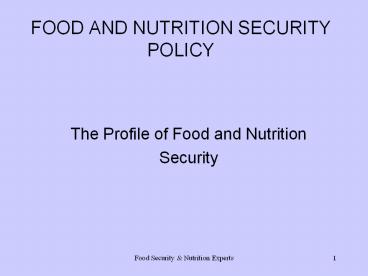FOOD AND NUTRITION SECURITY POLICY - PowerPoint PPT Presentation
1 / 30
Title:
FOOD AND NUTRITION SECURITY POLICY
Description:
Food Security & Nutrition Experts. 1. FOOD AND NUTRITION ... Price band abolished in 2001/02. Government still controlling maize price currently at K10/kg ... – PowerPoint PPT presentation
Number of Views:2216
Avg rating:3.0/5.0
Title: FOOD AND NUTRITION SECURITY POLICY
1
FOOD AND NUTRITION SECURITY POLICY
- The Profile of Food and Nutrition
- Security
2
HIGHLIGHTS OF THE PROFILE OF FOOD NUTRITION
SECURITY
- Nutritional Status
- National food balance
- Production
- Consumption
- Stability
- Cross-cutting issues
3
Nutritional status
- Ø Chronic and acute malnutrition
- Micronutrient malnutrition
- Mortality trends
4
Chronic and acute malnutrition
5
Prevalence of chronic energy deficiency (CED
BMIlt18.5)
6
Micronutrient Malnutrition - 2001
Only 36 of households consume adequately iodised
salt (?25 ppm)
7
Mortality Trends
8
National food balance
- 1961- 1995 food deficit in 19 out of 34 years
- 1995- 2003 food deficit in 5 out of 8 years
- In 2004, there is a high likelihood of food
deficit in the southern region
9
Domestic Production
- Ø Food production index
- Maize production trend
- Estate and smallholder agriculture
- Agriculture as of recurrent
- expenditure
- Constraints to agricultural
- production
10
(No Transcript)
11
(No Transcript)
12
(No Transcript)
13
(No Transcript)
14
Constraints to agriculture production
- Small landholdings lt 0.5 ha
- Low soil fertility
- Dependence on rain fed agriculture
- Limited access to agriculture inputs
- Limited access to credit
- Labour shortages on own farm due to ganyu
- Declining land and labour productivity due to
- Population pressure
- HIV/AIDS
- High input costs
15
Constraints to agriculture production continued
- Maize pricing
- 1995/96 price band introduced
- Price band abolished in 2001/02
- Government still controlling maize price
currently at K10/kg - Consequences
- Maize flows out due to the artificially low at
MK10/kg - No incentive for farmers to produce more maize
than they need. - No incentive for estates to grow maize
- Private traders cannot plan for imports
16
Input/output marketing
- Output marketing liberalized maize and tobacco
exports controlled. - Imports of raw agricultural products subject to
duty-free entry. - Malawi remains a net food importer
- Private sector participation in import and export
trade in food is liberalized and active - Export and Import bans effected.
17
(No Transcript)
18
Consumption
- Declining income levels
- Inequalities in consumption
- Dietary patterns
19
(No Transcript)
20
Inequalities in consumption
- 2/3 of population unable to meet the minimum
energy requirements (i.e.,2200 Kilocalorie) - 64 of population below poverty line
- 65 of rural population below poverty line
- The poorest 20 consume 6 of total national
consumption - The richest 10 consume 32
21
type of safety net programes recommended for
Malawi
- Expanded Public works programmes
- Targeted inputs program
- Targeted nutrition programs
- Direct voucher transfer to disadvantaged groups
- Are these safety nets effective for enhancing
food security - Are they useful for development or how about
during disasters??
22
Challenges for implementation of safety nets
- identification of appropriate type of safety nets
- targeting of the safety nets to the vulnerable
groups - financial, human and institutional capacity to
implement - effective monitoring systems to ensure effective
delivery - phasing out strategy
23
Dietary patterns
- General diet BULKY with LOW meal frequency
- Infant and young child feeding practices (98
breastfeeding, 72 initiated within 1 hour BUT
EBF only 63 (2000) up from 3 1992. - Complementary food plain porridge mostly cereal
based (about 80), BULKY with low frequency eg. - lt4 months 0.3
- 4-5 months 1.4
- 6-9 months 1.5
- Source MDHS, 2000
24
Stability
- Disasters and emergencies
- Seasonality of food production
- Food and nutrition security information systems
25
Occurrence and impact of disasters in Malawi
- Floods and drought, most frequent natural
disasters in Malawi - 1991/92 drought National maize production
fell by nearly 60 to 657,000 MT - In 2001, floods occurred in 13 districts,
contributed to about 32 drop in maize output - 2002/2003-food crisis the government spent about
US80 million to import maize - WFP has spent gtUS250 million on food aid for
Malawi in the past 25 years due to disasters
26
Tools for disaster management
- Disaster Preparedness and Relief Act, 1991.
Provisions of the act include establishment of - Office of the Commissioner capacity limited
- National Disaster Preparedness and Relief
Committee (NDPRC) - A disaster fund not yet established/ not
budgeted for - Disaster management plan still in draft since
1997
27
Tools for disaster management continued
- Strategic grain reserve (SGR) established in
1981 with capacity of 180,000 tones - objectives and uses of the SGR not well defined
- management and financing of the SGR NFRA
problematic - size of the SGR (physical stocks or financial
resources) - High cost of maintaining physical stocks
28
Current data/information domains relevant to FSN
- Agricultural statistics (crop production
estimates, livestock census, input output market
prices, food supply/demand) - Health and nutrition information (nutrition
indicators, health statistics) - Demographic and health statistics
- Poverty statistics
- Population statistics
- Socio-economic information (trade statistics,
exchange rates, inflation) - Natural resources information (land, water,
meteorology, environmental factors)
29
Major challenges on FSNIS
- Unavailability of accurate timely and up-to-date
data and information - Non-existence of a well structured and
coordinated food security and nutrition
information system. - Inadequate analytical capacity to provide
accurate and timely information - Inadequate access by most users (e.g. private
sector and NGOs)
30
Cross-cutting issues
- Gender imbalances
- Environment
- HIV/AIDS pandemic
- National adult prevalence (15 49) 14.4
- Urban 23.0
- Rural 12.4
- Number of infected children (0 14) 70,000
- 60,000 80,000
- No. infected adults over 50 years of age
60,000 - Total HIV population 900,000































